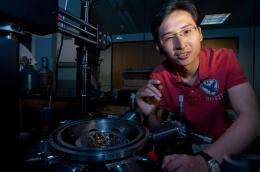Rice-made memory chips headed to space

Rice University will send an experiment to the International Space Station (ISS) later this year. If all goes perfectly, it will be precisely the same when it returns two years later.
Memory chips made of silicon oxide, the product of a breakthrough last year by the labs of Rice chemist James Tour, physicist Douglas Natelson and electrical and computer engineering professor Lin Zhong, will go aloft aboard a Russian Progress cargo ship in August for a lengthy stay at the ISS to see if radiation affects their nanoscale circuits.
Tour, Rice's T.T. and W.F. Chao Chair in Chemistry as well as a professor of mechanical engineering and materials science and of computer science, said the experiment is meant to show how well the sub-5-nanometer circuits stand up to the rigors of space, where constant bombardment by solar and other cosmic radiation poses an ever-present danger to both equipment and personnel.
Memory chips being created at Rice will be collected by NASA soon and packaged with other types of nonvolatile memories that don't depend on having to carry a charge, as common flash memory does.
They will be sent to Russia to fly on Progress 44, a cargo mission, as part of the HiMassSEE experiment. The intention is to characterize the effects of primary and secondary ionizing radiation on such circuitry.
Steven Koontz, ISS system manager for space environments, said, "We want to look at what happens at high shielding mass (that is, inside the ISS itself). The original motivation, and the largest part of the flight experiment content, really has to do with questions that are beginning to come up about secondary particle showers."
When nuclei collide at high energies, they scatter secondary particles in every direction -- just the kind of thing scientists are studying at places like the Large Hadron Collider and Brookhaven National Laboratory (a collaborator on HiMassSEE).
"When a heavy nucleus strikes a nucleus in the spacecraft, events that look like cosmic rays or showers are expected to occur," Koontz said. "We have been successfully ignoring those for many years because microelectronics didn't contain high-Z elements. They do now." Elements with high atomic numbers -- tungsten, hafnium, lead and gold -- are susceptible to disruption and raise the probability of failure in electronic components that use them, he said.
But silicon oxide circuits devised last year by Jun Yao, a graduate student in Tour's lab, contain no heavy metals, which makes them less likely to be destroyed by flying nuclei. Yao discovered that sending a current through silicon oxide, an insulator, could create a conductive pathway of silicon crystals. Electrical pulses could then repeatedly break and reconnect the pathway. That can be read as zero or one, the basic element of computer memory.
"The probability of a radiation event hitting that sub-5-nanometer wire is so small that it probably would never even get hit," Tour said. Earth-bound bombardment of silicon oxide circuits confirmed his suspicion. "In all of our tests, they've never been hit. So I presume it's going to work very well. And even if a circuit does get hit, you've only lost one memory bit. We're sending thousands of them."
Silicon oxide memory got wide attention last year for its potential to extend the boundaries of Moore's Law, which posits that integrated circuits would double in power every 18 months.
Computer scientists have long thought Moore would be no more once circuits got as small as 10 nanometers wide. Current commercially available processors sport 32-nanometer circuitry, and 28-nanometer fabrication is starting to come online.
While powerful computers are essential to space technology, power is less of an issue in this experiment than the ability to maintain coherence in the hostile environment of space, particularly for satellite circuitry or for missions to Mars and beyond.
The container holding the Rice chips, about the size of an Altoids tin, will stay inside the ISS with the rest of HiMassSEE. Rice's part of the experiment will return to campus in two years to be compared with identically configured chips that will remain at Tour's lab.
Yao made the centimeter-square chips in a Rice clean room. Although he will be long gone, doctorate in hand, when his chips come down to Earth, he said, "I'm excited because it's the first time in the Tour Group that something fabricated in the lab has been taken into space."
Provided by Rice University





















